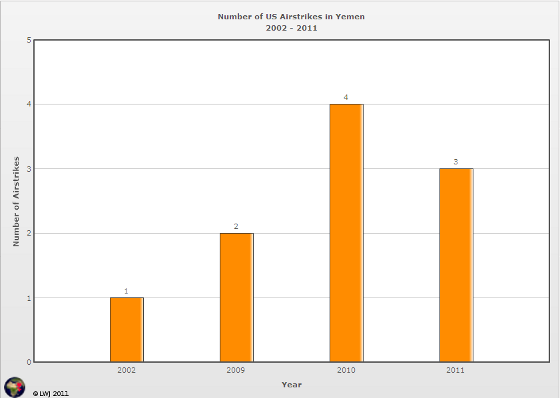| Click the chart to view The Long War Journal‘s page on US airstrikes in Yemen from 2002-2011. |
US aircraft targeted a police station in southern Yemen that had been recently taken over by fighters from al Qaeda in the Arabian Peninsula, according to reports from the region.
Six “Islamic militants” were killed in a nighttime airstrike on a police station in the town of Mudiya in Abyan province, a stronghold of al Qaeda in the Arabian Peninsula, a Yemeni official told The Associated Press. Yemeni officials said US aircraft carried out the strike and that the Yemeni Air Force does not have the ability to conduct strikes at night.
A report in the Yemeni newspaper Akhbar al Youm claimed the airstrike was conducted by the unmanned US Predators or Reapers, and said that more than 50 “al Qaeda militants” were killed in the attack.
The exact target of the strike is unclear. No senior al Qaeda leaders or operatives were reported to have been killed in the strike.
AQAP and Ansar al Sharia
Al Qaeda in the Arabian Peninsula has been fighting under the banner of the Ansar al Sharia, or the Army of Islamic law. Ansar al Sharia constitutes “AQAP’s version of the Islamic State of Iraq,” which is al Qaeda’s political and military front in Iraq, a senior US intelligence official told The Long War Journal. “Ansar al Sharia is pulling in allied Islamist groups and sympathetic tribes into its orbit, and seeks to implement an Islamic State much like the Taliban did in Afghanistan and al Qaeda attempted in Iraq,” he said.
In an official statement released by Ansar al Sharia in May 2011, the group said it wishes to take control of “all administrative, political, economic, cultural, monitoring, and other responsibilities” in Yemen.
AQAP is seeking to build an army to back up its Islamic state. Last summer, Qasim al Raymi, the military commander for al Qaeda in the Arabian Peninsula, and Mohammed Said al Umdah Gharib al T’aizzi, a senior AQAP military commander in southern Yemen, both claimed that the terror group had raised a 12,000-fighter-strong army in the southern Yemeni provinces. Yemeni officials recently told Al Hayah that “al Qaeda fighters in Zinjibar (the capital of Abyan) number in the hundreds, and perhaps exceed 2,000 gunmen.”
For the past several months, Yemeni security forces have been battling AQAP and allied Islamist groups for control of the south. AQAP is known to have openly taken control of areas in Abyan, Shabwah, Hadramawt, Marib, and Lahj since the onset of large anti-government protests in March. Government forces have withdrawn from major cities in the south, leaving an opening for al Qaeda and allied Islamist groups to seize control of several areas. In May, AQAP took over Zinjibar, the provincial capital of Abyan. And in June, AQAP seized Azzam, a city in Shabwa province. Now Yemenis describe the southern port city of Aden as ripe for an AQAP takeover.
The US is said to be taking advantage of the security vacuum in Yemen to step up attacks against AQAP’s top leaders and its network. Yemen has become enmeshed in a civil war that pits factions from the government, a rival military commander, the political opposition, various tribes, Shia Houthi rebels, and AQAP all against each other. Over the past several months, the fighting has intensified. President Ali Saleh has left the country for medical treatment after suffering a brain injury as well as burns on 40 percent of his body following an explosion at a mosque in the presidential compound in June.
Background on known US strikes in Yemen
The US is thought to have carried out at least nine air and missile strikes inside Yemen since December 2009 [see list below]. Other recent airstrikes are thought to have been carried out by the US also, but little evidence has emerged to link the attacks to the US.
The CIA is seeking to take over control of the strikes against AQAP in Yemen from the US military, which is currently operating the program. The CIA wants to use the unmanned Predator and Reaper strike aircraft, which the US employs for strikes against terrorist group based in Pakistan’s tribal areas. Currently, the US military has targeted AQAP in Yemen using cruise missiles and fixed-wing strike aircraft, although Predators are known to have been used in two of the strikes.
The most recent US strike, on June 3, killed Abu Ali al Harithi, a mid-level Qaeda operative, and several other AQAP commanders and fighters. A Predator strike on May 5, 2011 targeted Anwar al Awlaki, a top AQAP recruiter and ideologue who is an American citizen. Two mid-level AQAP operatives were said to have been killed in the attack.
One strike, a Tomahawk cruise missile attack on Dec. 17, 2009, hit what was thought to be a training camp run by al Qaeda in the Arabian Peninsula in the town of Ma’jalah in the province Abyan. The attack reportedly killed 14 al Qaeda fighters, along with 41 civilians.
Since December 2009, some of the top leaders of al Qaeda in the Arabian Peninsula have been targeted in airstrikes, including Abu Basir al Wuhayshi, the group’s leader; Said Ali al Shihri, the second in command; Abu Hurayrah Qasim al Raymi, the military commander; Ibrahim Suleiman al Rubaish, the top ideologue; and Anwar al Awlaki.
Yemen has become one of al Qaeda’s most secure bases and a hub for its activities on the Arabian Peninsula and on the Horn of Africa. AQAP maintains safe havens in various parts of the country and is also known to operate terror camps in Aden, Marib, Abyan, and in the Alehimp and Sanhan regions in Sana’a. The terror group has conducted attacks on oil facilities, tourists, the US embassy in Sana’a, and Yemeni security forces.
AQAP’s base in Yemen serves as a command and control center, a logistics hub, a transit point from Asia and the Peninsula, and a source of weapons and munitions for the al Qaeda-backed Shabaab in Somalia.
AQAP has also used its Yemeni base as a hub for attacks against the West. The 2009 Fort Hood shootings and the Christmas Day airline plot, as well as an airline parcel bomb plot in 2010, have all been traced back to Yemen.
“Yemen is Pakistan in the heart of the Arab world,” a US intelligence official told The Long War Journal in 2009. “You have military and government collusion with al Qaeda, peace agreements, budding terror camps, and the export of jihad to neighboring countries.”
Airstrikes in Yemen targeting Al Qaeda in the Arabian Peninsula since December 2009:
• July 14, 2011: US airstrike kills 6 al Qaeda fighters in Yemen: report
• June 3, 2011: US kills ‘mid-level’ AQAP operative in airstrike in southern Yemen
• May 5, 2011: Predator strike in Yemen targeted Anwar al Awlaki
• May 25, 2010: Yemeni airstrike kills deputy governor, al Qaeda operatives
• Mar. 14, 2010: Yemeni airstrike hits al Qaeda camp
• Jan. 20, 2010: Airstrikes target home of Yemeni al Qaeda leader
• Jan. 15, 2010: Al Qaeda’s military commander in Yemen reported killed
• Dec. 24, 2009: Yemeni airstrike targets top al Qaeda leaders
• Dec. 17, 2009: US launches cruise missile strikes against al Qaeda in Yemen
A look at 10 of the most dangerous Al Qaeda in the Arabian Peninsula leaders:










4 Comments
I am glad that JSOC, the CIA, and others are finally paying attention to Yemen which is so much more dangerous and vicious than Pakistan. We largely have killed off the main enemies of America’s forces in the form of al-Qaida Central. We need to go after alwaliki and others.
Bill- when I read the headline of your post, I was hoping that Adam Yahiye Gadahn’s name was listed as one of the newly deceased.
Maybe my wish will become reality, sooner rather than later.
The assassination of these men is good. However, we must kill the leaders of al-Qa’ida and their affiliate organizations. Too bad we didn’t get Anwar al-Awlaki.
@David,
USCENTCOM has been after AQAP for years now, even before the war in Iraq.
U.S has trained many government forces in Yemen, used drones on militants, and supported the failed Yemeni government for years.
With regards to this particular drone attack, CNN is reporting that up to 50 people were killed, and among them were 30 civilians. (Mostly relatives/family members of the militants)
http://goo.gl/E2Egh (CNN link)